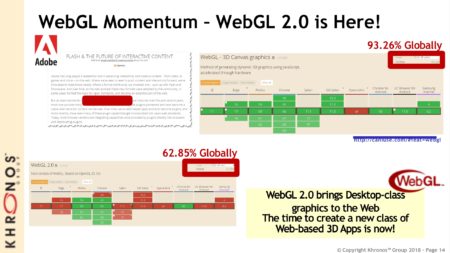Continued from page 1
Milestones on the Way to 2.0
There were many important milestones on route to WebGL 2.0, with Google Maps becoming one of the biggest users. It was a serious step in verifying the stability and longevity of WebGL.
While WebGL 1.0 was revolutionary because it produced accelerated 3D content on the web with no plugins, it was still modeled on an older API, OpenGL ES 2.0, that came with certain limitations. WebGL 2.0 was released in January 2017 on Chrome and Firefox, bringing in many new capabilities from OpenGL ES 3.0.
Designing WebGL 2.0 started by consolidating some of the functions that had been available through WebGL 1.0 extensions, and then reducing some of the restrictions that had been placed on WebGL to make sure it would run reliably in as many environments as possible. The resulting WebGL 2.0 is a much more flexible API that enables advanced effects with greater ease.

04 – The huge success of Onshape is partly a testament to its SaaS-based agile development model, and WebGL is the final tech that brings this app to life in the end user’s browser.
Updating the architecture of WebGL 2.0 functionality was the biggest single task, but the WebGL Working Group wasn’t alone. All new OpenGL ES features had to be added back into the old architecture, and Intel’s GPU team lent a hand, in both specifications and testing. NVIDIA also contributed to the spec, testing, and implementation efforts. Every aspect of the API was upgraded in some way, and each upgrade was thoroughly tested. Conformance testing alone took nearly a year, but it was necessary to define a consistent behavior and a consistent API set across a range of devices and browsers.
The Khronos Group Ecosystem and the Future of WebGL
As has been discussed on this site many times, WebGL is a pivotal technology behind professional 3D applications delivered via a SaaS (software as a service) model. Key new MCAD applications like Onshape are completely SaaS-based CAD applications working through your modern browser.
Before WebGL, you couldn’t really do 3D on the web at all. There was powerful 3D hardware everywhere on both desktops and mobile phones, but the web couldn’t tap into any of it.
The importance of WebGL being created and maintained within Khronos shouldn’t be understated. Khronos brought together the browsers and the GPU vendors, and WebGL’s success is a direct result of tight design cooperation between those communities. Khronos has a long history of bringing those two communities together under one proven IP framework, which is important from a legal standpoint.
Low-Level Explicit API Directions
With the new era of explicit, low-level graphics APIs like Vulkan, a natural interest for those behind WebGL is moving aspects of it in that direction. The Khronos Group welcomes industry discussion around evolving WebGL in that direction. Experience developing WebGL has shown that web API experts, GPU vendors, and native API experts are all needed at the table when designing such an API, and Khronos is the one organization with a proven track record of bringing these experts together.
“Before WebGL, you couldn’t really do 3D on the web at all. There was powerful 3D hardware everywhere on both desktops and mobile phones, but the web couldn’t tap into any of it,” says Vukićević. “There were some plugins, but users had to do an extra installation step that was a huge obstacle to adoption. All the browser vendors knew that this was a challenge that needed to be resolved, which is why we came together as a Khronos Working Group.”

05 – WebGL 2.0 momentum is building as the new standard becomes more widely adopted, backed up by universal support of WebGL 1.0 in all the leading browsers. (image: Khronos Group / Architosh. All rights reserved.)
The Khronos Group admit that WebGL 2.0 was a huge undertaking, but the efficiency, speed, and resource improvements from WebGL 1.0 are very clear. WebGL 2.0 speeds up some rendering techniques, such as deferred shading, and enables new ones, such as stateful particle systems via transform feedback, and volumetric rendering using 3D textures. This improved efficiency leads to better quality and performance at a lower price, improving battery usage on mobile devices.
WebGL—A Natural Part of the Fabric of the Web
WebGL has become a natural part of the web, reliably producing consistent 3D graphics across platforms and browsers. WebGL has 97 percent activation on Firefox and is looking to round that out to 100. WebGL 2.0 implementation is expected on nearly every browser, as it is with WebGL 1.0, along with adding key extensions that will dramatically increase the power of writing WebGL applications.
WebGL 2.0 offers new capabilities, and with WebGL 1.0 still around as the solid foundation, the expectation is that WebGL will continue to effectively and reliably provide 3D graphics with no plugins and the highest level of security.
“From the beginning, my goal was to be on every browser,” concludes Vukićević.
Major browser vendors Apple (Safari), Google (Chrome), Microsoft (Edge), and Mozilla (Firefox) are members of the WebGL Working Group. If you are interested in finding out more about WebGL or accessing the specification, please visit www.khronos.org/webgl



Reader Comments
[…] next page: Milestones on the Way to 2.0 […]
Comments are closed.